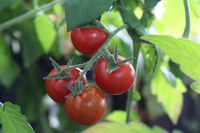Prairie Fare: How to Donate Fresh Vegetables and Fruits Safely
(Click an image below to view a high-resolution image that can be downloaded)
By Julie Garden-Robinson, Food and Nutrition Specialist
NDSU Extension
Jake was standing by my raised garden eyeing the ripe red tomatoes the other day.
He sat and gazed longingly at the tomatoes he couldn’t reach. I could see his nose sniffing the air.
I walked over to pick him up and carry him inside. He ran to the other side of the garden and began barking and dancing on his hind legs.
As you have guessed, Jake is a dog. Being a dachshund, Jake’s hind legs (and front legs) are fairly short. He would need to pole vault to get into my raised gardens.
As I carried him to the house, I plucked a small grape tomato. He ate it in one bite and looked at me with appreciative eyes.
Unfortunately, I probably will regret my actions. He will bark for a tomato treat each time he is outside.
Several years ago, we had a low raised bed with a fence around it to keep out Jake as well as a group of rabbits.
By the way, for your trivia knowledge, a group of rabbits is called a “fluffle” or a “colony.”
The fluffle wasn’t the issue. Jake was. When we found him in the garden munching on tomatoes and squash, Jake escaped over the fence and hurt himself.
That led to the raised beds. Crawling around on the ground to pick weeds is not so easy for us humans, either. Jake’s injury brought about easier gardening practices for us and safer ones for all of us.
Some gardeners are fortunate to have prolific gardens this year, despite a low rainfall in many areas. You may have enough to donate, as well as eat fresh and preserve to enjoy later.
If you are donating produce, be sure to check with a local food pantry or other donation site ahead of time. They may have some special directions. States may vary in their guidelines.
The following information is from a handout titled “Food Safety for Donation Gardens” from the Iowa State University Food Safety Modernization Act website. Fresh produce often is eaten without cooking, so special precautions are in place.
- Keep pets and wild animals away from your produce by using fences or raised beds. Wild and domesticated animals can carry bacteria and other germs, which are difficult to remove with rinsing.
- Use safe drinking water to rinse visible dirt from produce and dry the produce thoroughly before donating.
- Harvest produce into clean and sanitized bins with clean utensils. Place the harvest container on top of a blanket or stool and do not let it rest on the ground.
- Wash your hands before, during and after handling produce.
- Discard or compost produce that is bruised or has fallen on the ground.
- Transport produce in a vehicle that is clean, covered and maintained at a cool temperature.
- When harvesting produce, be sure you are well and also practice good hygiene. Wear clean clothes and shoes. If you have long hair, tie it back. Avoid wearing jewelry because stones could fall out and lead to hazards in the final product. If you are ill with a fever or diarrhea, do not handle ready-to-eat food.
- Keep your cellphone out of the garden to avoid recontaminating your hands with your phone.
Preserving food is another way to avoid waste. Visit https://www.ag.ndsu.edu/food and navigate to “food preservation” to find a variety of resources about canning, drying, freezing, pickling and fermenting.
Be cautious where you get your food preservation materials. Do not can food in an oven, dishwasher or microwave oven. Follow the rules for safety. If you cannot locate canning lids, freeze your produce. You may can it later when canning supplies become more readily available.
You might be inspired to make your own home-canned condiments using tested recipes. This recipe is from the “Complete Guide to Home Canning,” Agriculture Information Bulletin No. 539, U.S. Department of Agriculture. It also is featured in “Make Your Own Home-canned Condiments” on the NDSU Extension website.
Country Western Ketchup
24 lb. ripe tomatoes
5 chili peppers, sliced and seeded
1/4 c. salt
2 2/3 c. vinegar (5% acetic acid)
1 1/4 c. sugar
1/2 tsp. ground red pepper (cayenne)
4 tsp. paprika
4 tsp. whole allspice
4 tsp. dry mustard
1 Tbsp. whole peppercorns
1 tsp. mustard seeds
1 Tbsp. bay leaves
Wash tomatoes. Dip in boiling water for 30 to 60 seconds or until skins split. Dip in cold water Slip off skins and remove cores. Quarter tomatoes into 4-gallon stock pot or a large kettle. Add chili peppers and red pepper. Bring to boil and simmer 20 minutes, uncovered. Combine spices in a spice bag and add to vinegar in a 2-quart saucepan. Bring to boil. Turn off heat and let stand until tomato mixture has been cooked 20 minutes. Then remove spice bag and combine vinegar and tomato mixture. Boil about 30 minutes. Put boiled mixture through a food mill or sieve. Return to pot. Add sugar and salt, boil gently and stir frequently until volume is reduced by one-half or until mixture mounds up on spoon without separation. Fill clean, hot pint jars, leaving 1/8 inch head space. Process in a boiling water-bath canner for 15 minutes if your altitude is less than 1,000 feet, or for 20 minutes if your altitude is 1,001 to 6,000 feet. If you live in an altitude above 6,000 feet, process for 25 minutes. This recipe yields six to seven pint jars. (This recipe can be frozen, too.)
(Julie Garden-Robinson, Ph.D., R.D., L.R.D., is a North Dakota State University Extension food and nutrition specialist and professor in the Department of Health, Nutrition and Exercise Sciences. Follow her on Twitter @jgardenrobinson)
NDSU Agriculture Communication - Aug. 12, 2021
Source: Julie Garden-Robinson, 701-231-7187, julie.garden-robinson@ndsu.edu
Editor: Ellen Crawford, 701-231-5391, ellen.crawford@ndsu.edu




